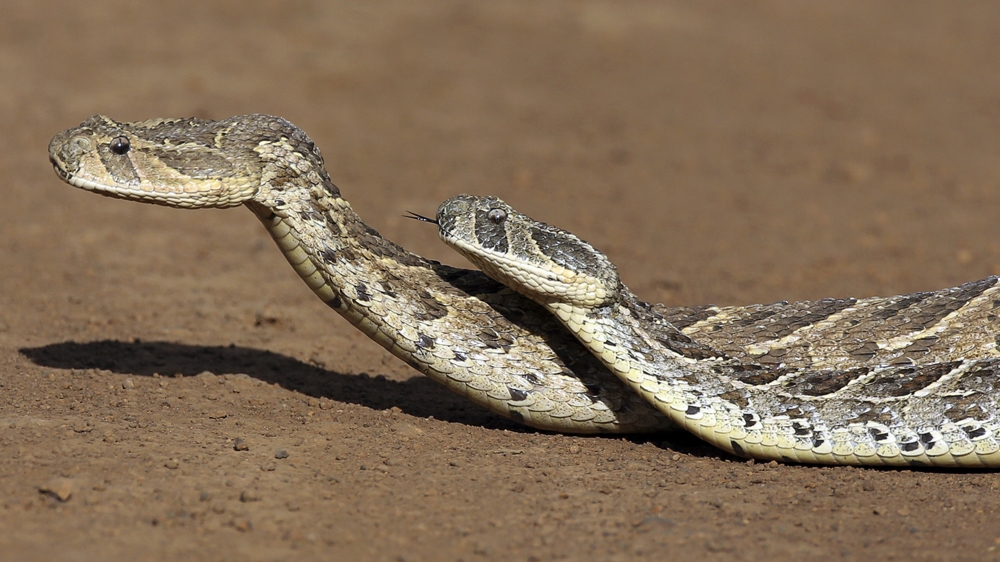Baringo County, Kenya - Simotwo village in Baringo, a western county in Kenya, is a peaceful place. Cattle, sheep and goats graze leisurely. The grassy area straddles hillocks, boasts a generous outcrop of granite rocks and is rich in indigenous tree cover.
But beneath the veneer of calm village life, a deadly menace haunts the residents and their livestock.
The semi-arid environment of Simotwo and most parts of Baringo County are favourable habitats for a number of snake species.
This is a fact Kelly Simba, 34, knows too well.
In April, he was walking along a narrow path to his uncle's home, carrying a stick in his right hand which he occasionally used to turn a stone or move a branch.
It was hot and water was scarce, so he stopped to get water for his cattle. As he poured it into a trough, he felt a sharp sting on his left foot.
Wincing in pain, he jumped up and managed to catch a glimpse of the puff adder, a long and heavy snake that relies on its camouflage, as it disappeared.
If not treated appropriately, a puff adder bite can be fatal.
"There was an old cloth on the fence nearby, so I took it and tore a strip to tie my foot. I then called a bodaboda (motorcycle taxi) to take me to hospital in Kabartonjo," said Simba.
Kabartonjo sub-district hospital is rated level four by Kenya's Ministry of Health, meaning it is better equipped than the pharmacies in and near Simotwo.
It took him three hours to get to the hospital; he was treated and discharged after three days.
The level of awareness is very low. Not many people know what to do and therefore, many succumb to the bites.HESBORN NYAMBATI, SNAKE EXPERT AT THE NATIONAL MUSEUMS OF KENYA
In the village of Simotwo, everyone knows someone who's been bitten by a snake.
Despite the local government's efforts, barriers to solving the snakebite problem include poor road networks, the lack of public health education and absence of anti-venom in rural health facilities.
Daisy Chepnyango, 18, from the neighbouring Karas village was also bitten by a puff adder.
Her mother carried her the 15 kilometres (9.3 miles) to Kimalel Hospital for treatment.
In the case of Simba's nine-year-old nephew, Brian Kipsang, he had just finished a school day and was carrying water from a nearby stream when he felt a stinging pain at his ankle.
Like Simba, he was also rushed to hospital on a motorbike, arriving two hours later.
Simba, Chepnyango and Kipsang were the lucky ones, managing to make it from a rural area to a hospital. Many others are less fortunate, and succumb in the countryside.
Poor infrastructure
There is no exact data on the number of snakebites across Kenya.
Dr Winnie Bore, chief officer for health in Baringo County, said: "Conservative figures of victims of snakebites in Baringo County is between 200 to 300 per month. A third of these succumb to the bite."
She cited efforts to distribute anti-venom to all health facilities in affected areas, train clinicians in dealing with snakebites, and educate residents on how to avoid snakebites.
Hesborn Nyambati, a snake expert at the National Museums of Kenya, said if someone is bitten, the first step is to minimise motion - and therefore, warned against running.
But poor infrastructure areas like Simotwo means the only way to travel quickly is by motorbike, on a bumpy road.
Bore admitted that the roads needed improving, saying: "There is a correlation between health outcomes and road networks, especially in cases like snakebites or even maternal and childcare."
In health facilities where there is no electricity, Bore claimed to be working towards installing solar power so that anti-venom that needs refrigeration can be stored. In county areas where the snakebite rate is particularly high, she said officials were planning to stock medicine that does not need to be refrigerated.
Simba and other villagers Al Jazeera interviewed said a local facility does not stock anti-venom.
"The health centre closes at five in the evening, so in case a patient is brought in there at night, there will be no one to attend to him," he said. "In any case, they do not treat snake-bites and do not have an admission ward."
Kenya is in the initial stages of setting up a facility that extracts poison from snakes to produce anti-venom, but it will take time before this is available for use in hospitals.
Currently, the government imports anti-venom from South Africa.
According to snake expert Nyambati, this is sometimes problematic because anti-venom produced from poison extracted from one environment may not be effective on a snakebite in a different environment.
These challenges have prompted some residents to try alternative treatment.
source: aljazeera




